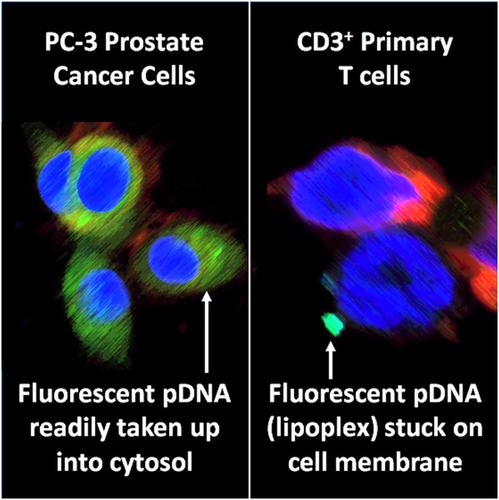当前位置:
X-MOL 学术
›
Biotechnol. Bioeng.
›
论文详情
Our official English website, www.x-mol.net, welcomes your
feedback! (Note: you will need to create a separate account there.)
Nonviral gene delivery to T cells with Lipofectamine LTX
Biotechnology and Bioengineering ( IF 3.5 ) Pub Date : 2021-01-22 , DOI: 10.1002/bit.27686 Emily Harris 1 , Devon Zimmerman 1 , Eric Warga 1 , Anil Bamezai 2 , Jacob Elmer 1
Biotechnology and Bioengineering ( IF 3.5 ) Pub Date : 2021-01-22 , DOI: 10.1002/bit.27686 Emily Harris 1 , Devon Zimmerman 1 , Eric Warga 1 , Anil Bamezai 2 , Jacob Elmer 1
Affiliation

|
Retroviral gene delivery is widely used in T cell therapies for hematological cancers. However, viral vectors are expensive to manufacture, integrate genes in semirandom patterns, and their transduction efficiency varies between patients. In this study, several nonviral gene delivery vehicles, promoters, and additional variables were compared to optimize nonviral transgene delivery and expression in both Jurkat and primary T cells. Transfection of Jurkat cells was maximized to a high efficiency (63.0% ± 10.9% EGFP+ cells) by transfecting cells with Lipofectamine LTX in X‐VIVO 15 media. However, the same method yielded a much lower transfection efficiency in primary T cells (8.1% ± 0.8% EGFP+). Subsequent confocal microscopy revealed that a majority of the lipoplexes did not enter the primary T cells, which might be due to relatively low expression levels of heparan sulfate proteoglycans detected via messenger RNA‐sequencing. Pyrin and HIN (PYHIN) DNA sensors (e.g., AIM2 and IFI16) that can induce apoptosis or repress transcription after binding cytoplasmic DNA were also detected at high levels in primary T cells. Therefore, transfection of primary T cells appears to be limited at the level of cellular uptake or DNA sensing in the cytoplasm. Both of these factors should be considered in the development of future viral and nonviral T cell gene delivery methods.
中文翻译:

使用 Lipofectamine LTX 将非病毒基因递送至 T 细胞
逆转录病毒基因传递广泛用于血液癌症的 T 细胞疗法。然而,病毒载体的制造成本很高,以半随机模式整合基因,并且它们的转导效率因患者而异。在这项研究中,比较了几种非病毒基因传递载体、启动子和其他变量,以优化 Jurkat 和原代 T 细胞中的非病毒转基因传递和表达。 通过在 X-VIVO 15 培养基中用 Lipofectamine LTX 转染细胞,将 Jurkat 细胞的转染效率最大化(63.0% ± 10.9% EGFP +细胞)。然而,相同的方法在原代 T 细胞中产生的转染效率要低得多(8.1% ± 0.8% EGFP +)。随后的共聚焦显微镜显示大多数脂质复合物没有进入原代 T 细胞,这可能是由于通过信使 RNA 测序检测到的硫酸乙酰肝素蛋白聚糖的表达水平相对较低。在原代 T 细胞中也检测到高水平的 Pyrin 和 HIN (PYHIN) DNA 传感器(例如,AIM2 和 IFI16),它们可以在结合细胞质 DNA 后诱导细胞凋亡或抑制转录。因此,原代 T 细胞的转染似乎受限于细胞摄取或细胞质中 DNA 感应的水平。在开发未来的病毒和非病毒 T 细胞基因递送方法时,应考虑这两个因素。
更新日期:2021-03-17
中文翻译:

使用 Lipofectamine LTX 将非病毒基因递送至 T 细胞
逆转录病毒基因传递广泛用于血液癌症的 T 细胞疗法。然而,病毒载体的制造成本很高,以半随机模式整合基因,并且它们的转导效率因患者而异。在这项研究中,比较了几种非病毒基因传递载体、启动子和其他变量,以优化 Jurkat 和原代 T 细胞中的非病毒转基因传递和表达。 通过在 X-VIVO 15 培养基中用 Lipofectamine LTX 转染细胞,将 Jurkat 细胞的转染效率最大化(63.0% ± 10.9% EGFP +细胞)。然而,相同的方法在原代 T 细胞中产生的转染效率要低得多(8.1% ± 0.8% EGFP +)。随后的共聚焦显微镜显示大多数脂质复合物没有进入原代 T 细胞,这可能是由于通过信使 RNA 测序检测到的硫酸乙酰肝素蛋白聚糖的表达水平相对较低。在原代 T 细胞中也检测到高水平的 Pyrin 和 HIN (PYHIN) DNA 传感器(例如,AIM2 和 IFI16),它们可以在结合细胞质 DNA 后诱导细胞凋亡或抑制转录。因此,原代 T 细胞的转染似乎受限于细胞摄取或细胞质中 DNA 感应的水平。在开发未来的病毒和非病毒 T 细胞基因递送方法时,应考虑这两个因素。











































 京公网安备 11010802027423号
京公网安备 11010802027423号